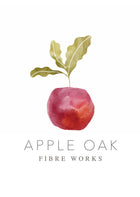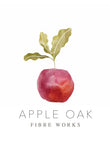This was probably the most challenging module so far. I love Madder, don't get me wrong, but there is something about Madder that challenges me. Perhaps its sensitivity to water, its delicate colour shifts and the pressure it puts me under when I pronounce I am going to have madder reds in this years collection! Though, that is really me doing that. My water is highly unsuitable for madder reds - partly too acidic and no Calcium present at all - hence why I always turn to cochineal for reds on protein fibres.
Madder dyed fibres and madder roots
Madder's long history of the perfect red on cotton - also known as Turkish red - is most intriguing and probably one of the biggest challenges to any natural dyer; hence why I like to give it a wide berth. Nonetheless, it needed to be tackled for this course as well as for our linen embroidery threads and I finally had no excuse. I did however, managed to skip around the actual dyeing of Turkish red - my excuse: It takes a dedicated 2+ weeks to create and involves occasional tight time frames, something that would not suit most participants of this one year long course. Also, it uses oil and I have to ensure that our filtration system can actually handle that - but don't be sad!
Though we won't embark on the dyeing of Turkish red for now, there is a full lesson dedicated to Turkish red dyeing - its history, how it came about, how it can be done and perhaps one student will take on the challenge...
I achieved a number of nice reds on the linen thread though, I will be sharing results soon.
Madder isn't the only red dye we work with, cochineal is the other and being quite familiar with those little bugs filled with anthraquinone colour, there are a number of interesting recipes to try - unless you are vegetarian/vegan, in which case it will be Madder only.
Cochineal dyed wool skeins
Have a look below to see what will be covered in the red chapter:
Dyer's Madder ~ a historical timeline
- Madder ~ a short history
- The Leyden Papyrus
- A timeline
Dyer's Madder ~ From root to Garacine
- Quality Control
- From Root to powder
- The hunt for Alizarin and its siblings
- The making of Garancine from Madder
Sources of Plants trich in Anthraquinone
- What are Anthraquinone rich plants?
- Dyer's Madder
- Wild Madder
- Dyer's Woodruff
- Sweet Woodruff
- Yellow Lady's bedstraw
- Hedge Bedstraw
- Scotch Mist
- Northern Bedstraw
Turkish Red Dyeing
- A history
- The process
- Development
- The recipes
- Conclusion
The Story of Cochineal and other red bearing insects
- An introduction
- Dyer's Kermes
- The life cycle
- Dyer's Kermes ~ A short history
- Dyeing with Dyer's Kermes
- American Cochineal
- The life cycle
- Cochineal ~ A short history
- Dyeing with Cochineal
- The Lac Insect
- Common or Indian Lac insect
- Dyeing with Lac
Using red dyes in your studio
Madder recipes on protein
Madder recipes on cellulose
Cochineal on protein
Cochineal on cellulose
___________________________________
Join the Natural Dyers Academy by clicking here
Receive the professional course specific newsletter by clicking here






Leave a comment